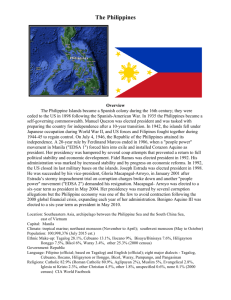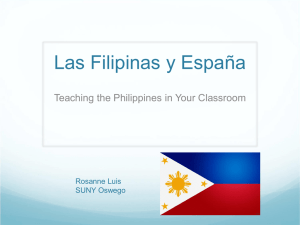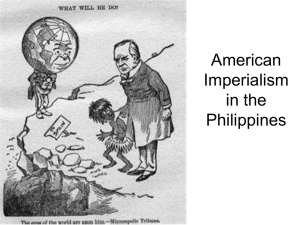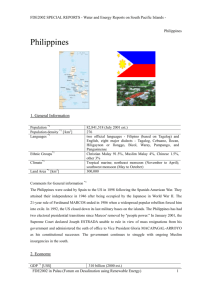I. Description II. Economy
advertisement
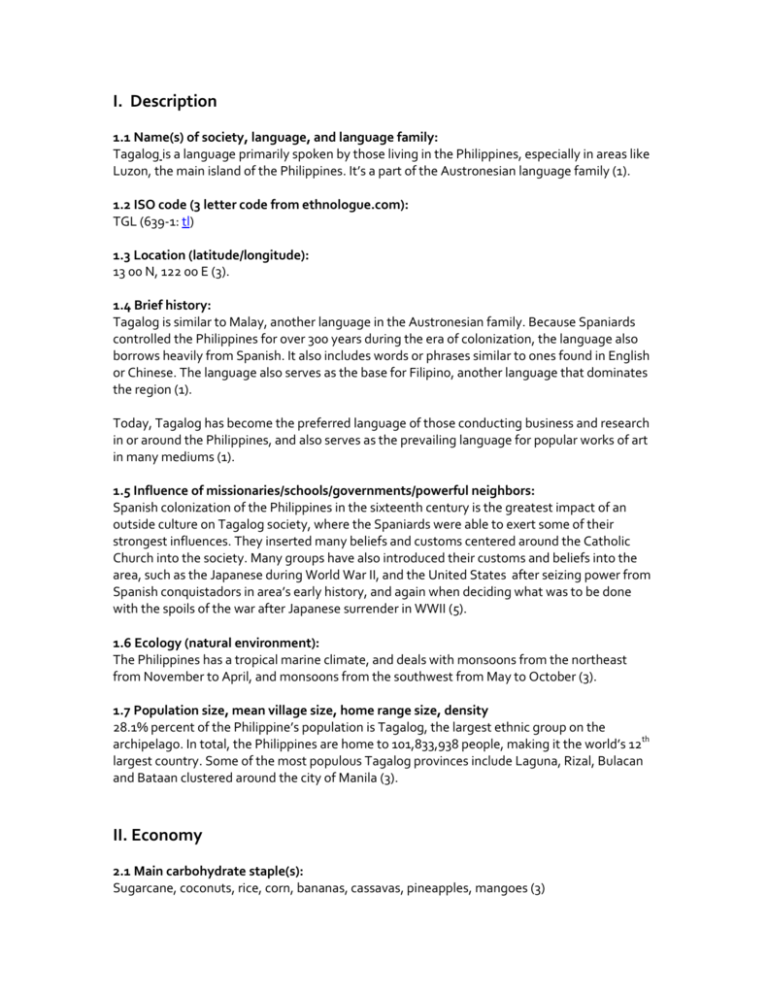
I. Description 1.1 Name(s) of society, language, and language family: Tagalog is a language primarily spoken by those living in the Philippines, especially in areas like Luzon, the main island of the Philippines. It’s a part of the Austronesian language family (1). 1.2 ISO code (3 letter code from ethnologue.com): TGL (639-1: tl) 1.3 Location (latitude/longitude): 13 00 N, 122 00 E (3). 1.4 Brief history: Tagalog is similar to Malay, another language in the Austronesian family. Because Spaniards controlled the Philippines for over 300 years during the era of colonization, the language also borrows heavily from Spanish. It also includes words or phrases similar to ones found in English or Chinese. The language also serves as the base for Filipino, another language that dominates the region (1). Today, Tagalog has become the preferred language of those conducting business and research in or around the Philippines, and also serves as the prevailing language for popular works of art in many mediums (1). 1.5 Influence of missionaries/schools/governments/powerful neighbors: Spanish colonization of the Philippines in the sixteenth century is the greatest impact of an outside culture on Tagalog society, where the Spaniards were able to exert some of their strongest influences. They inserted many beliefs and customs centered around the Catholic Church into the society. Many groups have also introduced their customs and beliefs into the area, such as the Japanese during World War II, and the United States after seizing power from Spanish conquistadors in area’s early history, and again when deciding what was to be done with the spoils of the war after Japanese surrender in WWII (5). 1.6 Ecology (natural environment): The Philippines has a tropical marine climate, and deals with monsoons from the northeast from November to April, and monsoons from the southwest from May to October (3). 1.7 Population size, mean village size, home range size, density 28.1% percent of the Philippine’s population is Tagalog, the largest ethnic group on the archipelago. In total, the Philippines are home to 101,833,938 people, making it the world’s 12th largest country. Some of the most populous Tagalog provinces include Laguna, Rizal, Bulacan and Bataan clustered around the city of Manila (3). II. Economy 2.1 Main carbohydrate staple(s): Sugarcane, coconuts, rice, corn, bananas, cassavas, pineapples, mangoes (3) 2.2 Main protein-lipid sources: Pork, eggs, beef, and fish (3) 2.3 Weapons: Bow and arrow, blowguns? The Philippines actually benefits from a highly respected, volunteer-based military composed of an army, a navy, a coast guard, and an air force. The army also includes the Philippines National Police. Areas of concern are continuously monitored by different branches of this military (6). 2.4 Food storage: As the Philippines have become increasingly modernized, food storage trends have kept up. Modern-day technology is implemented only when needed. With many meals eaten during the day, leftover storage isn’t a huge concern amongst Tagalog families (8). 2.5 Sexual division of production: Jobs in agriculture are traditionally reserved for men. Few women work in the fields since the man is traditionally viewed as the head of the household and is thus responsible for providing food and resources for his family (5). Professional occupations show blurred gender lines however, as women are seen as being equal in status to men (6). 2.6 Land tenure: During the Spanish colonial period, land became clustered in the hands of a few powerful elites. Efforts have been made ever since the Spanish lost power to distribute land in a fairer manner in order to increase and protect social stability, especially in rural areas (4). Major land reform efforts dominated the political landscape of the Philippines throughout the 1970s and 1980s, and comprehensive legislative and executive actions have been taken to continue efforts to allot land in an equal manner. Squabbles still continue though regarding the effectiveness of these reforms since progress is often slow, if at all noticeable (4). 2.7 Ceramics: 2.8 Specified (prescribed or proscribed) sharing patterns: Land reform and who is entitled to what areas have undergone significant reform since legislation was passed in the 1970s. Currently, about 60 percent of lands required to be divided and spread amongst citizens has been accounted for (6). Within a family, land is divided equally without regard to sex or age, and families are expected to share plots of land (2). 2.9 Food taboos: With it’s checkered colonial past, Filipinos have learned to welcome a variety of flavors and dishes into their diets. Many foreign dishes are adapted based on ingredients and cooking procedures that are readily available in one’s region. This idea is almost the opposite of a taboo! (8). 2.10 Canoes/watercraft? III. Anthropometry 3.1 Mean adult height (m and f): Men: 163.5 cm (5' 4.4") Women: 151.8 cm (4' 11.8") (9) 3.2 Mean adult weight (m and f): IV. Life History, mating, marriage 4.1 Age at menarche (f): 4.2 Age at first birth (m and f): The birth of a woman’s first child traditionally follows soon after marriage. Women in rural areas marry around age 20.3, while those living in urban areas marry around age 21.4 (5). 4.3 Completed family size (m and f): According to a National Demographic and Health Survey from 1998, the urban crude birth rate was at 25.8 births, while the rural rate was at 30.1. The total fertility rate was 3.01 for urban areas and 4.67 for rural areas (5). 4.4 Inter-birth-interval (f): While an exact interval is hard to calculate, there’s been a trend in recent years to encourage mothers to breastfeed their children mainly because of supposed benefits to mother and child breastfeeding creates, but also to slow population growth. This recent change in social pattern has led to an increase in the amount of time between births. 4.5 Age first marriage (m and f): Rural women traditionally marry earlier than urban women, around the age of 20.3, while urban women marry at around age 21.4 (5). Men are expected to marry by their late 20s. Median age for marriage is 22 (6). 4.6 Proportion of marriages ending in divorce: Divorce is illegal, but marriages can become annulled if there’s evidence of things like domestic violence or pressure to change one’s religious or political beliefs (6). 4.7 Percent marriages polygyous, percent males married polygynously: All marriages are theoretically polygnous. Divorce is not allowed, but marriages may be annulled if a husband is suspected of cheating (6). 4.8 Bride purchase (price), bride service, dowry?: N/A 4.9 Inheritance patterns: Land follows a multi-lineal inheritance pattern for real and personal property. Fields are usually divided and separated, and backed by proper notation in the Civil Code. Offspring usually receive an equal share of land regardless of age or gender (2). 4.10 Parent-offspring interactions and conflict: It’s often expressed by Tagalog youth that mothers love the youngest child best, primarily because of the intimacy and difficulty of childbirth. Within the nuclear family, corporal punishment is commonplace for misbehaving. Activities such as toilet training however, are relaxed, casual affairs. Parents have been described as being flexible, rational, and even impulsive at times. Emotional expressiveness is encouraged. Additionally, children are also raised by the entire extended kin group (2). 4.11 Homosexual activities, social attitudes towards homosexuals: Homosexuality is legal throughout the Philippines, and there are no laws prohibiting homosexual behavior. The island chain was actually one of the first groups to recognize groups specifically created for those in the LGBTQ community. In 2009, the military ended a ban on gays serving in the military. However, because of the large influence the Catholic church exerts on society, homosexual activities can also be discouraged, sometimes described as “tolerating but not accepting” (10). 4.12 Pattern of exogamy (endogamy): Marriages can take place between members of the same community, but never between members of the same family. While interfaith marriages are not common, marriages that cross linguistic boundaries are becoming more widely accepted (5) (6). 4.13 What is the belief of the role of males in conception; is paternity partible? Are these “other fathers” recognized? There are many folk beliefs surrounding conception and pregnancy. Several examples include giving the mother anything she desires or she will have a miscarriage and stepping over a husband while sleeping in order to share some of the pains and troubles associated with pregnancy (11). 4.14 What is the belief of the mother’s role in procreation exactly? (e.g., “receptacle in which fetus grows”) Most folk beliefs surrounding the mother are superstitions about what’s unlucky during a pregnancy. Superstitions include the fear that the mother will miscarry if her picture is taken while pregnant, and visitors that linger at the door instead of entering the main room of the house will cause a painful, complicated pregnancy for the mother (11). 4.15 Is conception believed to be an incremental process (i.e., semen builds up over time)? Beliefs centering around conception are closely aligned with the viewpoint outlined by the Catholic church. Remaining a virgin until marriage is stressed, and conception is theoretically solely reserved for the point of procreation, not for pleasure (12). 4.16 Occurrence of sexual coercion, rape Sexual coercion or rape is most prevalent in migrant women workers, especially those in a domestic or entertainment industry job. In 1997, an anti-rape law was passed that clarified rape as a pubic offense, and attempted to cut down the number of sexual assaults and rape incidents (12). 4.17 Preferential category for spouse (e.g., cross cousin) Non-relative 4.18 Do females enjoy sexual freedoms? Women are free to serve as head of the household, and are traditionally trusted with making a lot of the decisions necessary to keep the house running. A husband’s salary is typically turned over to his wife so she can purchase whatever it is the family needs. Extramarital affairs however, are frowned upon (2). 4.19 Evidence of giving gifts to extramarital partners or extramarital offspring Children are encouraged to develop a strong relationship with their god parents, and are taught to respect family above all else (2). 4.20 If mother dies, whose raises children? The father or other kin would be responsible for raising children (5). 4.21 Adult sex ratio: number of adult males divided by number of (reproductive) females The sex ratio in the 1990s was 191 females for every 100 males (5). 4.22 Evidence for couvades N/A 4.23 Different distinctions for potential fathers (e.g., lesser/younger vs. major/older) N/A 4.24 Kin avoidance and respect? Kin are the recipients of maximum respect in Filipino society, as detailed throughout the questionnaire. Even the most distant of relatives theoretically receives more respect than a close neighbor or friend (2). 4.24 Joking relationships? 4.25 Patterns of descent (e.g., bilateral, matrilineal) for certain rights, names or associations There is no word in Tagalog for “in-law,” indicating that there is no marked difference in perception of one’s own parents and those of their spouse. They do however, distinguish between their brothers and sisters and those of their partner (2). 4.26 Incest avoidance rules Currently, there is no law formerly prohibiting incest. It’s highly discouraged though, based on the nature of society and the role family plays (12). 4.27 Is there a formal marriage ceremony? There is a formal service conducted by city officials. The bride and groom are expected to find sponsors that show their status and importance in the community. Sometimes during the ceremony, a groom will give his bride a coin to symbolize her role as the head of the family’s monetary policy (6). It’s expected that as many relatives as possible attend (2). 4.28 In what way(s) does one get a name, change their name, and obtain another name? Traditionally, Tagalog society has displayed "bilateral indifference" in naming. There were no surnames and a child might be identified as "the first child of" either the mother or the father, but the arrival of the Spanish prompted a switch in the use of a first and last name like most European societies presently use. The Civil Code in modern day society requires a married woman to use her husband's name. Within a barrio, a woman may formally be addressed by her maiden name (2). 4.29 Is marriage usually (or preferred to be) within community or outside community? (m/f difference?) Community isn’t necessarily a determining factor for marriage, with men and women even marrying across linguistic lines. Migration patterns and movement towards busier urban areas have encouraged this practice in recent decades (5). 4.30 Are marriages arranged? Who arranges (e.g., parents, close kin)? Many romantic notions, including the idea of marriage are based on Spanish and American definititions of “romantic love.” Kin do not arrange marriages, but it’s expected that as many relatives as possible attend the wedding. The new couple is also expected to visit anyone in their extended families that were not able to make it to the ceremony. If parents are unusually disapproving, elopement is always an option for Tagalog lovers (2). 4.31 Evidence for conflict of interest over who marries who: Because Tagalog society is so dependent on good relations with kin and those in your community, all efforts to minimize conflicts of interest would be taken (2). Warfare/homicide 4.14 Percent adult (male) deaths due to warfare: 4.15 Outgroup vs ingroup cause of violent death: 4.16 Reported causes of in-group and out-group killing: 4.17 Number, diversity and relationship with neighboring societies (external relations): Neighbors regularly engage in trade with the Philippines. Most relationships are peaceful. There are particular areas however, especially those owned by China, that are slightly more contentious and are closely surveyed by the military. 4.18 Cannibalism? N/A V. Socio-Political organization and interaction 5.1 Mean local residential (village) group size: Traditionally, Tagalog families live in villages known as “barrios.” Each of these barrios can have anywhere from ten to 1,000 individual houses clustered near each other (2). In 1990, nearly six out of every ten Filipinos lived in villages or barangays. Each barangay consisted of a number of sitios or neighborhoods made from clusters of households. Loyalty in Filipino society lies first to family members, and then to those in your sitio. Each sitio comprised 15 to 30 households, and most barangays numbered from 150 to 200 households. Each barangay also has a school, one or two small retail stores, and a small Roman Catholic chapel. (4). 5.2 Mobility pattern: (seasonality): Migration is minimal in the Philippines since social structure is heavily reliant on close ties to kin and those living in one’s community. There is minimal migration of those primarily looking for work, especially if there is little land owned by the family living in a rural area. Poverty, hunger, and malnutrition are driving some families to migrate from rural areas to urban centers in pursuit of work (5). In recent years, there’s been a significant number of Filipinos working or moving abroad to locations such as the United States, Hong Kong, Singapore, New Zealand, and other first-world countries (5). 5.3 Political system: (chiefs, clans etc, wealth or status classes): Each barrio has at least one “teniente del barrio,” the generally recognized political leader of his respective barrio. This leader is expected to share authority with elders living in the community though, when concerns about the general welfare of the group are raised (2). 5.4 Post marital residence: Families live in a structure known as a nipa hut that, while spacious, is often home to just one family. Newly married couples can stay with relatives for a short period of time, but are encouraged to construct their own home as soon as possible, often receiveing help from those in their family and community (2). 5.6 Social interaction divisions ? (age and sex): Philippine citizens are known for a high display of amor proprio (self-esteem) and good, peaceful interpersonal relationships. There’s much respect displayed for older family members, as well as anyone in a position of power, also dictated by age (4). Despite favoritism of the male sex in Catholicism, Filipinos don’t create distinct identities or recognize distinctive differences between the sexes beyond obvious physical constructions (2). 5.7 Special friendships/joking relationships: Relationships are always carefully built upon the maintenance of one another’s self-esteem. If one member of a society insults or challenges the self-esteem of another, it’s often a reason to terminate the relationship (4). The relationship between a child and his or her compadrazgo (godparent) is also special. It’s a way to enlarge one’s kin group to make it more likely the child will receive jobs, loans, favors, or gifts throughout their lifetime (4). An utang na loob relationship exists between an two individuals, one of whom owes the other. Philippine culture dictates that a debt can never be fully repaid, resulting in a steady, long-term relationship between two people (4). Suki relationships develop in the business world, where two individuals decide to enter into an agreement as supplier and customer. This results in good business relations for the foreseeable future, and can lead to other benefits and favors if needed by one of the individuals (4). 5.8 Village and house organization: A primary source of interaction for those living in a barrio is the “sari-sari” store, typically run by a woman from the village who purchases food and then sells it to local housewives (2). There’s quite a bit of emphasis on working together to accomplish major tasks amongst those living in a community. A community member’s first obligation is to their family members, then to other barrio members (2). 5.9 Specialized village structures (mens’ houses): Families live together as a unit, without separate structures for men (6). 5.10 Sleep in hammocks or on ground or elsewhere? 5.11 Social organization, clans, moieties, lineages, etc: Societies tend to be marked by alliance systems composed of different families (kin groupings), those who have granted or received favors and are thus, favorably looked upon, and partners in commercial or business ventures (4). 5.12 Trade: Due to the effects of globalization and modernization, the Philippines have become a major trading partner with countries around the world like the U.S., the EU, and Japan. Rice, bananas, cashews, pineapple, mangoes, and coconut products serve as primary exports, along with equipment, machinery, and clothing. The United States, members of the European Union, and Japan are the major trading partners. Businesses must import other consumer goods and fuel (6). 5.13 Indications of social hierarchies? Family comes first in this society, and is where a kin member’s obligations primarily stem from. Loyalty and trust is extended to kin first and foremost, including extended family members. Trust and loyalties lie to a lesser extent with those nearby, resulting in the degree of seriousness a relationship becoming dependent on physical location (4). VI. Ritual/Ceremony/Religion (RCR) 6.0 Time allocation to RCR: Most members of the community attend a weekly Sunday Mass, and participate in special holiday events. Women attend Mass more frequently than men (4). 6.1 Specialization (shamans and medicine): Although the Philippines has undergone great health care advances in the last few decades, many natives combine a modern medicine approach with traditional practices. Tradition dictates that illness occurs when one breaks taboos established by supernatural forces (4). One example of traditional practices is the “psychic surgeon,” a healer that claimed the ability to perform operations without drawing blood or using common surgical tools like a scalpel (4). 6.2 Stimulants: During the later half of the 20th century, the Philippines struggled with its reputation as a center of drug trafficking and shipping. Drugs like marijuana and methamphetamine (known locally as shabu) were commonly shipped to places such as Hong Kong, Japan, Australia, and the U.S. This problem continues to perplex local, national, and international authorities (6). 6.3 Passage rituals (birth, death, puberty, seasonal): The two biggest holidays on the Catholic calendar, Christmas and Easter, are both celebrated with a blending of traditional and local traditions. At Christmas time, people attend misas de gallo, a special Christmas mass held in the early morning for nine days, ending in a midnight mass on Christmas Eve. After this service, families traditionally gather and share a large meal. Again, emphasis is strongly placed on family and kin, including extended relatives like godparents (4). Around Easter time, towns will read and reenact the events that serve as the basis of the holiday. This reading or reenactment is an example of the indebtedness most Filipinos feel they have with Christ (4). 6.4 Other rituals: Each town hosts a fiesta to pay homage to the town’s patron saint, and to mark the sense of community inherent to most Philippine societies. Everyone is invited into houses in the community to enjoy tons of food. The festivities also include a Mass, but the bigger focus teds to be on events like a dance, sporting tournaments, parades, carnivals, and other events designed to encourage visiting and socializing with those you live with (4). 6.5 Myths (Creation): Catholicism in the Philippines combines elements of traditional practices similar to what one would find across Europe with folklore and traditions unique to the area. Two aspects of the Holy Trilogy, the Father, who is worshiped in accordance with how society views traditional father figures, and the son or Jesus, who is said to have died for the sins of each individual are both worshiped in services. One scholar describes the relationship as “a cosmic compadrazgo, and an utang na loob [discussed in section V] to Christ, for his sacrifice transcended any possible repayment . . . . To the devout Filipino, Christ died to save him; there could be no limit to an individual's thanksgiving” (4). 6.6 Cultural material (art, music, games): As the Philippines, like many other places around the planet become more homogenous as a result of globalization, many new organizations and structures such as the Cultural Center of the Philippines located in Manila, the capital of the country, strive to protect the traditions and heritages of many groups that call the archipelago home, including those associated with the Tagalog culture (6). Music is also popular, and folk tunes played on a guitar or flute are played alongside popular tunes from places like the U.S. in homes and schools, as well as at fun-filled events like fiestas (6). There are also a slew of popular Filipino dramas with origins dating back to the period of Spanish colonization, when plays were used to instruct those new to Catholicism all about what was required to live a morally appropriate life. Current dramas tend to reflect daily life, as well as nationalistic sentiments (6). Many popular or well-known dances are also a unique blend of Spanish and Filipino culture. Professional troupes perform all kinds of different dances, while folk dances with a strong Spanish influence are performed at meetings and conferences, and indigenous dances are used in historical showcases (6). 6.7 Sex differences in RCR: Roman Catholicism greatly favors the role of the male in a family or community, but this aspect of the Catholic faith is surprisingly dormant throughout Tagalog society. Social values and customs are more likely to stress gender equality, believing sexes must be equal in order to get ahead in life and further one’s self (6). 6.8 Missionary effect: As a result of Spanish settlement in the 16th century, about 82 percent of the population of the Philippines is Roman Catholic. Islam accounts for another 5 percent, with small sects of other Christian churches, Buddhists, Daoists and tribal animists sprinkled around the archipelago as well (4). 6.9 RCR revival: Recent centers in Manila, the capital of the Philippines, have been created with the sole purpose of preserving and sharing cultural history and colonial background with natives (6). Several tribes living in more remote island locations also follow certain ceremonial or religious practices more faithfully than those living in more modern, urban centers (5). 6.10 Death and afterlife beliefs: When someone dies, a twenty-four-hour vigil is held before a religious ceremony is held. The body is then escorted to the cemetery to be buried in an edifice that symbolizes the position of the deceased, with mourners following behind the coffin. Mourning continues for another six weeks after the death (6). 6.11 Taboo of naming dead people? N/A 6.12 Is there teknonymy? N/A 6.13 Briefly describe religion (animism, ancestor worship, deism, magic, totems etc.) Families mark All Saint’s Day where they meet at the cemetery to clear the gravesite and share food and memories in remembrance of those who have died. During other visits paid periodically throughout a year, a family member will place pebbles on the grave to show that the deceased will always be remembered (6). VII. Adornment 7.1 Body paint: 7.2 Piercings: 7.3 Haircut: 7.4 Scarification: 7.5 Adornment (beads, feathers, lip plates, etc.): 7.6 Ceremonial/Ritual adornment: 7.7 Sex differences in adornment: 7.8 Missionary effect: 7.9 Cultural revival in adornment: VIII. Kinship systems 8.1 Sibling classification system: Children are distinguished by birth order and sex. Ate signals the eldest girl; ditse, the second oldest girl; sanse, the third oldest girl; kuya for the eldest boy; diko for the second oldest boy; and sangko, for the third oldest boy (2). All older siblings also have authority over any younger ones, with the oldest child earning the greatest amount of authority (2). 8.2 Sororate, levirate: N/A 8.3 Other notable kinship typology, especially cross-cousin (MBD/FZD) typology (Crow/Hawaiian/Omaha etc.): N/A IX. Other interesting cultural features (list them): Education is considered extremely important, since college degress are considered necessary for a good, secure job with advancement opportunities. The education system in the Philippines greatly resembles school systems in most of the Western world, with a department of education that has authority over educational affairs. Students are expected to wear uniforms that correspond to the school they attend (6). Numbered references 1. "TAGALOG AT NIU." SEAsite - SE Asian Languages and Cultures. Northern Illinois University. Web. 15 Feb. 2012. <http://www.seasite.niu.edu/Tagalog/tagalog_mainpage.htm>. 2. American Anthropologist, New Series, Vol. 59, No. 2 (Apr., 1957), pp. 236-249 Published by: Blackwell Publishing on behalf of the American Anthropological Association. http://www.jstor.org/stable/665223. 3. "CIA - The World Factbook." Welcome to the CIA Web Site — Central Intelligence Agency. Web. 15 Feb. 2012. <https://www.cia.gov/library/publications/the-worldfactbook/geos/rp.html>. 4. "A Country Study: Philippines." Country Studies. The Library of Congress. Web. <http://lcweb2.loc.gov/frd/cs/phtoc.html>. 5. Gultiano, Socorro, and Peter Urich. Population Dynamics, Land Availability and Adapting Land Tenure Systems: Philippines, a Case Study. Paris: CICRED, 2003. Print. 6. "Culture of The Philippines." Countries and Their Cultures. Web. 15 Feb. 2012. <http://www.everyculture.com/No-Sa/The-Philippines.html>. 7. Zarate, Ernesto. "Filipino Building Beliefs." Subcommision on the Arts. National Commission for Culture and the Arts. Web. <http://www.ncca.gov.ph/about-culture-and-arts/articles-on-c-na/article.php?igm=1&i=106>. 8. Kirshenblatt-Gimblett, Barbara, and Doreen G. Fernandez. "Culture Ingested: On the Indigenization of Phillipine Food." Gastronomica 3.1 (2003): 58-71. Print. 9. "Height Chart of Men and Women in Different Countries." Disabled World. Web. 15 Feb. 2012. <http://www.disabledworld.com/artman/publish/height-chart.shtml>. 10. "UNHCR | Refworld | Philippines: Treatment of Homosexuals by Society and Government Authorities; Recourse and Protection Available to Homosexuals Who Have Been Subject to Ill-treatment." UNHCR Welcome. Web. 15 Feb. 2012. <http://www.unhcr.org/refworld/publisher,IRBC,,PHL,4e438f742,0.html>. 11. "Filipino Folk Beliefs FS." SEAsite - SE Asian Languages and Cultures. Web. 15 Feb. 2012. <http://www.seasite.niu.edu/Tagalog/Folk_Beliefs/filipino_folk_beliefs.htm >. 12. "FILIPINO WOMEN AND SEXUAL VIOLENCE: SPEAKING OUT AND PROVIDING SERVICES." Solidarity Philippines Australia Network (SPAN). Web. 15 Feb. 2012. <http://cpcabrisbane.org/CPCA/IWSSForum.htm>.

